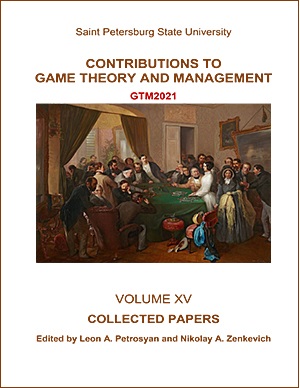Modeling of the City’s Transport Network Using Game-Theoretic Methods on the Example of Petrozavodsk
DOI:
https://doi.org/10.21638/11701/spbu31.2022.02Abstract
Keywords:
transport network, correspondence matrix, centrality measures, equilibrium flows
Downloads
Download data is not yet available.
References
Arrowsmith, G. (1973). A behavioural approach to obtaining a doubly constrained trip distribution model. Journal of the Operational Research Society, 24(1), 101–111
Avrachenkov, K., Kondratev, A. Yu., Mazalov, V. V. and Rubanov, D. G. (2018). Network partitioning as cooperative games. Computational social networks, 5(11), 1–28
Ford, W., Lien, J. W., Mazalov, V. V. and Zheng, J. (2019). Riding to Wall Street: determinants of commute time using Citi Bike. International Journal of Logistics Research and Applications, 22(5), 473–490
Gasnikov, A. V. (ed.) (2013). Introduction to mathematical modeling of traffic flows, Moscow, MCCME Publishing House, 2013, 196 p. (in Russian)
Kerner, B. S. (2009). Introduction to modern traffic flow theory and control. The long road to three-phase traffic theory. Springer
Mazalov V. V. and Khitraya V. A. (2021). A Modified Myerson Value for Determining the Centrality of Graph Vertices. Automation and Remote Control, 82(1), 145–159
Mazalov, V. V. and Trukhina, L. I. (2014). Generating functions and the Myerson vector in communication networks. Diskr. Mat., 26(3), 65–75
Nagurney, A. (1999). Network Economics: A Variational Inequality Approach. Dordrecht: Kluwer Academic Publishers
Nesterov, Yu. and de Palma, A. (2003). Stationary dynamic solutions in congested transportation networks: summary and perspectives. Networks and Spatial Economics, 3, 371–395
Nurminsky, E. A. and Shamray, N. B. (2010). Predictive modeling of car traffic in Vladivostok. Proceedings of the Moscow Institute of Physics and Technology. V. 2, 4(8), 119–129 (in Russian)
Sheffy, Y. (1985). Urban Transportation Networks: Equilibrium Analysis with Mathematical Programming Methods, Prentice-Hall, Englewood Cliffs, N.J
Shvetsov, V. I. (2003). Mathematical Modeling of Traffic Flows. Automation and Remote Control, 64, 1651–1689
Shvetsov, V. I. (2009). Algorithms for distributing traffic flows. Automation and Remote Control, 70, 1728–1736
Wardrop, J. (1952). Some Theoretical Aspects of Road Traffic Research // Proceedings of the Institute of Civil Engineers
Wilson, A. G. (1967). A statistical theory of spatial distribution models. Transportation research, 1(3), 253–269
Downloads
Published
2023-01-25
How to Cite
Ermolin, N. A., Khitraya, V. A., Khitryi, A. V., Mazalov, V. V., & Nikitina, N. N. (2023). Modeling of the City’s Transport Network Using Game-Theoretic Methods on the Example of Petrozavodsk. Contributions to Game Theory and Management, 15, 18–31. https://doi.org/10.21638/11701/spbu31.2022.02
Issue
Section
Articles
License
Articles of "Contributions to Game Theory and Management" are open access distributed under the terms of the License Agreement with Saint Petersburg State University, which permits to the authors unrestricted distribution and self-archiving free of charge.




